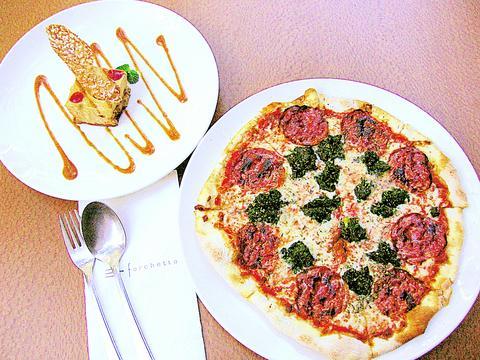Over the past six months, Max Tseng (
A veteran of the kitchens of Haoyang (

PHOTO: GAVIN PHIPPS, TAIPEI TIMES
And with the summer weather settling in, the simple and well-ventilated dinning area is a real treat. Max's design includes a huge glass facade, which, when fully open, gives the already spacious joint an even greater sense of space.
The dining environment is a major draw, but the food certainly cannot be ignored. A combination of Italian and Spanish with a bit of French, the dishes on the menu might not be as numerous as other European-styled joints, but for presentation and taste, Forchetta outclasses many, if not all, its rivals.
Forchetta's range of tapas include Spanish-style bread (NT$100), asparagus wrapped with Parma ham and Dijon pommary (NT$150), and roasted foie gras with fig sauce (NT$380). While a bit costlier than the average starter, Forchetta's Bufalo mozzarella with tomatoes (NT$360) is well worth the extra cost, especially when you consider that Max imports the cheese especially for this dish.
At present, Forchetta's pasta dishes are somewhat limited, with most of the half-dozen choices topped with seafood. These include linguini with crab and mushroom sauce (NT$260), penne with anchovies and olives (NT$260) and linguini with clam and white wine sauce (NT$260). According to Max, the pasta menu is set to change some time in the coming weeks when he plans to add new dishes to the pasta menu.
While the tapas and pasta dishes are faultless, it's Max's mouth-watering pizzas that have tongues wagging. The secret to Max's pizza is the crust. Not greasy, not soggy, and certainly not chewy.
Forchetta's pizza combinations include the absolutely fantastic spinach, salami, gorgonzola and mozzarella (NT$380) and the equally tasty, yet saucily spicy sausage, mushroom and mozzarella (NT$320). For cheese lovers, the gorgonzola, brie, ricotta and mozzarella (NT$380) comes highly recommended.
For those out to wine as well as dine, Forchetta offers a variety of both Old and New World wines, all of which are reasonably priced at between NT$700 and NT$1,500 as well as a good choice of bottled European beers at NT$170 a pop.

Oct. 27 to Nov. 2 Over a breakfast of soymilk and fried dough costing less than NT$400, seven officials and engineers agreed on a NT$400 million plan — unaware that it would mark the beginning of Taiwan’s semiconductor empire. It was a cold February morning in 1974. Gathered at the unassuming shop were Economics minister Sun Yun-hsuan (孫運璿), director-general of Transportation and Communications Kao Yu-shu (高玉樹), Industrial Technology Research Institute (ITRI) president Wang Chao-chen (王兆振), Telecommunications Laboratories director Kang Pao-huang (康寶煌), Executive Yuan secretary-general Fei Hua (費驊), director-general of Telecommunications Fang Hsien-chi (方賢齊) and Radio Corporation of America (RCA) Laboratories director Pan
The consensus on the Chinese Nationalist Party (KMT) chair race is that Cheng Li-wun (鄭麗文) ran a populist, ideological back-to-basics campaign and soundly defeated former Taipei mayor Hau Lung-bin (郝龍斌), the candidate backed by the big institutional players. Cheng tapped into a wave of popular enthusiasm within the KMT, while the institutional players’ get-out-the-vote abilities fell flat, suggesting their power has weakened significantly. Yet, a closer look at the race paints a more complicated picture, raising questions about some analysts’ conclusions, including my own. TURNOUT Here is a surprising statistic: Turnout was 130,678, or 39.46 percent of the 331,145 eligible party

The classic warmth of a good old-fashioned izakaya beckons you in, all cozy nooks and dark wood finishes, as tables order a third round and waiters sling tapas-sized bites and assorted — sometimes unidentifiable — skewered meats. But there’s a romantic hush about this Ximending (西門町) hotspot, with cocktails savored, plating elegant and never rushed and daters and diners lit by candlelight and chandelier. Each chair is mismatched and the assorted tables appear to be the fanciest picks from a nearby flea market. A naked sewing mannequin stands in a dimly lit corner, adorned with antique mirrors and draped foliage

The older you get, and the more obsessed with your health, the more it feels as if life comes down to numbers: how many more years you can expect; your lean body mass; your percentage of visceral fat; how dense your bones are; how many kilos you can squat; how long you can deadhang; how often you still do it; your levels of LDL and HDL cholesterol; your resting heart rate; your overnight blood oxygen level; how quickly you can run; how many steps you do in a day; how many hours you sleep; how fast you are shrinking; how